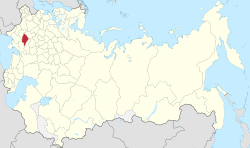| Poltava Governorate Полтавская губерния | |||||||||||||||||
|---|---|---|---|---|---|---|---|---|---|---|---|---|---|---|---|---|---|
| Governorate of the Russian Empire (1802–1917) and Ukrainian successor states (1917–25) | |||||||||||||||||
| 1802–1925 | |||||||||||||||||
 Poltava Governorate in 1913 | |||||||||||||||||
 Location in the Russian Empire | |||||||||||||||||
| Capital | Poltava | ||||||||||||||||
| Area | |||||||||||||||||
• (1897) | 49,894 km2 (19,264 sq mi) | ||||||||||||||||
| Population | |||||||||||||||||
• (1897) | 2,778,151 | ||||||||||||||||
| History | |||||||||||||||||
• Established | 1802 | ||||||||||||||||
• Abolished | 1925 | ||||||||||||||||
| Political subdivisions | 15 uezds (1802–1923) 7 okruhas (1923–25) | ||||||||||||||||
| |||||||||||||||||
| Today part of | Poltava Oblast Kharkiv Oblast Kyiv Oblast Sumy Oblast | ||||||||||||||||
Poltava Governorate [a] was an administrative-territorial unit ( guberniya ) of the Russian Empire. It was officially created in 1802 from the disbanded Little Russia Governorate and had its capital in Poltava.
Contents
- History
- Demographics
- Largest towns and cities
- Native Languages
- Religion
- Administrative divisions
- Notes
- References
- External links
Its borders encompassed the modern Poltava Oblast of Ukraine, in addition to Berestyn, Pereiaslav, Romny and Zolotonosha.
It was bordering the Chernigov and Kursk Governorates to the north, Kiev Governorate to the west, Kharkov Governorate to the east and the Kherson and Yekaterinoslav Governorates to the south.

















